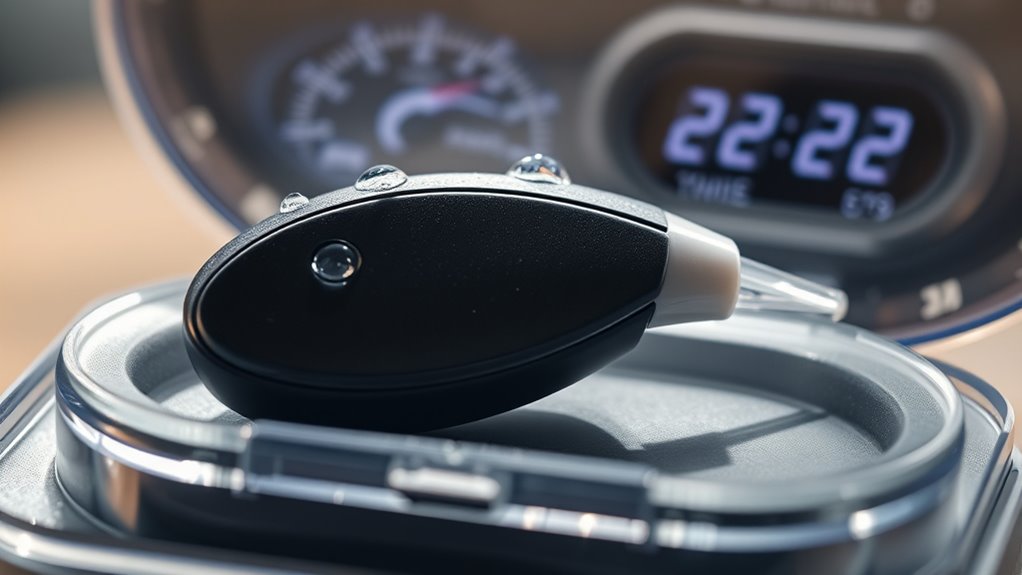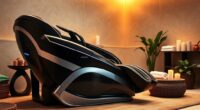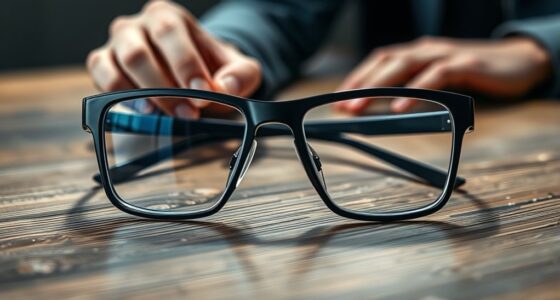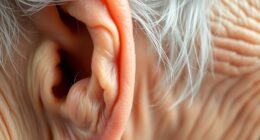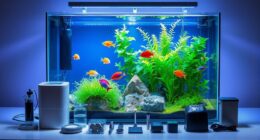To safeguard your hearing devices from humidity, keep them dry with moisture barriers, regularly check for signs of moisture damage, and store them in cool, dry places away from direct sunlight. Use desiccants or dehumidifiers to reduce humidity levels and monitor environmental conditions to prevent corrosion and malfunction. Proper storage and maintenance extend your device’s lifespan and ensure peak performance. If you want to learn more about humidity protection strategies, continue exploring these essential tips.
Key Takeaways
- Use moisture barriers and waterproofing features to prevent humidity ingress and protect hearing devices.
- Regularly inspect for signs of moisture damage like corrosion or audio distortions.
- Store devices in cool, dry environments utilizing silica gel packets and humidity-controlled containers.
- Employ dehumidifiers and desiccants to actively reduce ambient humidity levels around hearing tech.
- Avoid high-humidity environments and remove batteries when not in use to extend device lifespan.
How Humidity Impacts Hearing Device Performance
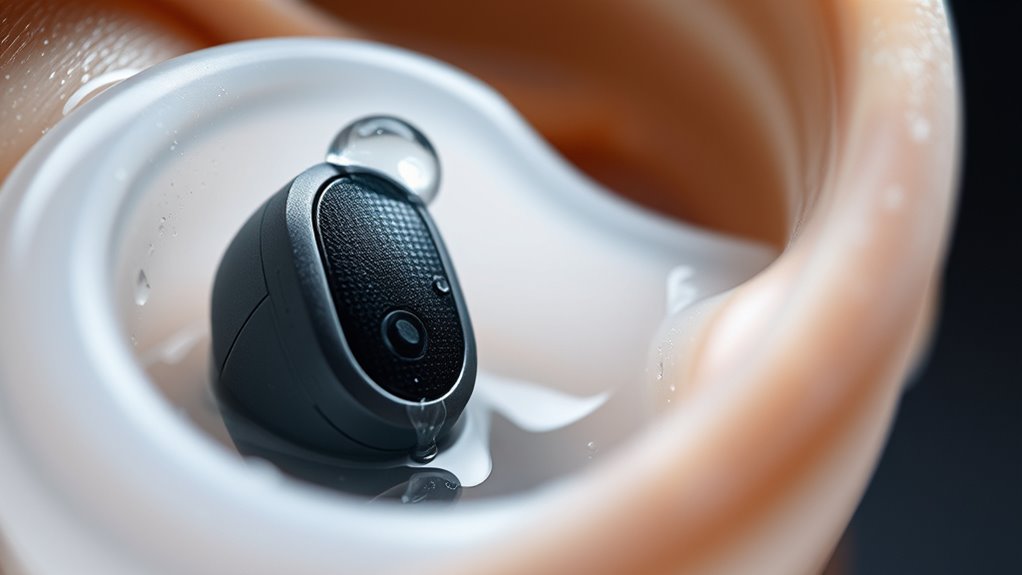
Humidity can substantially affect how your hearing devices perform. Excess moisture can interfere with their functionality, causing issues like reduced sound quality or device failure. Modern hearing aids often include humidity sensors that detect moisture levels, alerting you when humidity becomes a concern. To protect your devices, moisture barriers are essential; these thin covers prevent water and humidity from entering sensitive components. Without proper protection, humidity can lead to corrosion and damage, shortening your device’s lifespan. Regularly checking humidity levels and using moisture barriers helps maintain ideal performance. Keep in mind, high humidity environments demand extra precautions, like removing your devices when showering or swimming, to prevent moisture buildup and ensure your hearing tech stays in top shape. Additionally, understanding AI in Education advancements can help you stay informed about innovative protective technologies and smart solutions for device management.
Common Signs of Humidity Damage in Hearing Tech
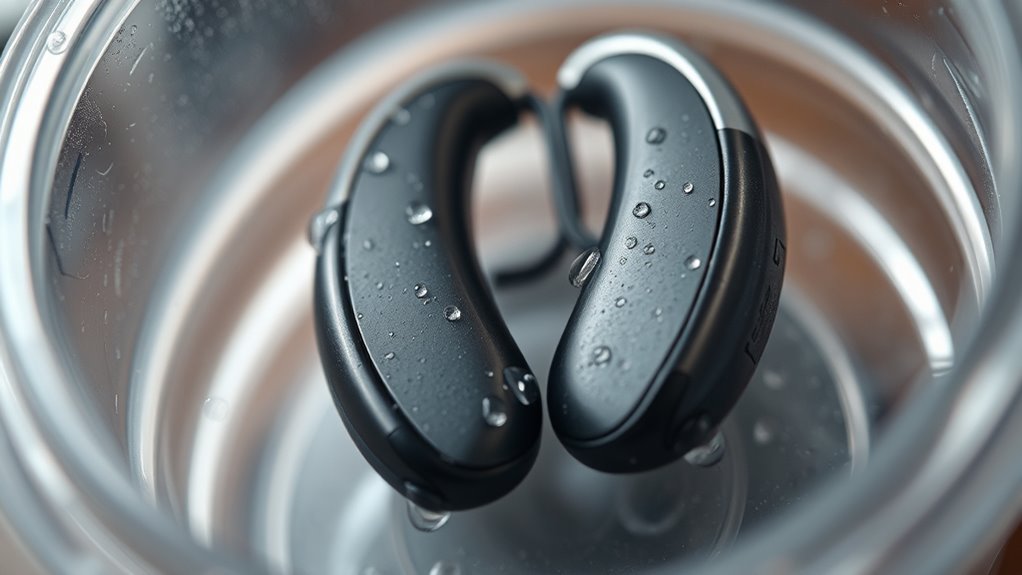
When moisture infiltrates your hearing devices, you might notice several telltale signs indicating damage. One common sign is the appearance of corrosion, often visible as discoloration or rust on metal parts. You may also experience intermittent functionality or audio distortions, which suggest internal damage. Mold growth can develop inside or around your hearing aids, leading to a musty odor and potential health concerns. If you notice any of these signs—corrosion, mold, or inconsistent performance—it’s a clear indication that humidity has compromised your device. Ignoring these issues can lead to further damage and costly repairs. Regular inspections and prompt action can help protect your investment and ensure your hearing device functions at its best. Being aware of humidity damage signs can help you take early steps to preserve your hearing technology.
The Science Behind Moisture and Electronic Components
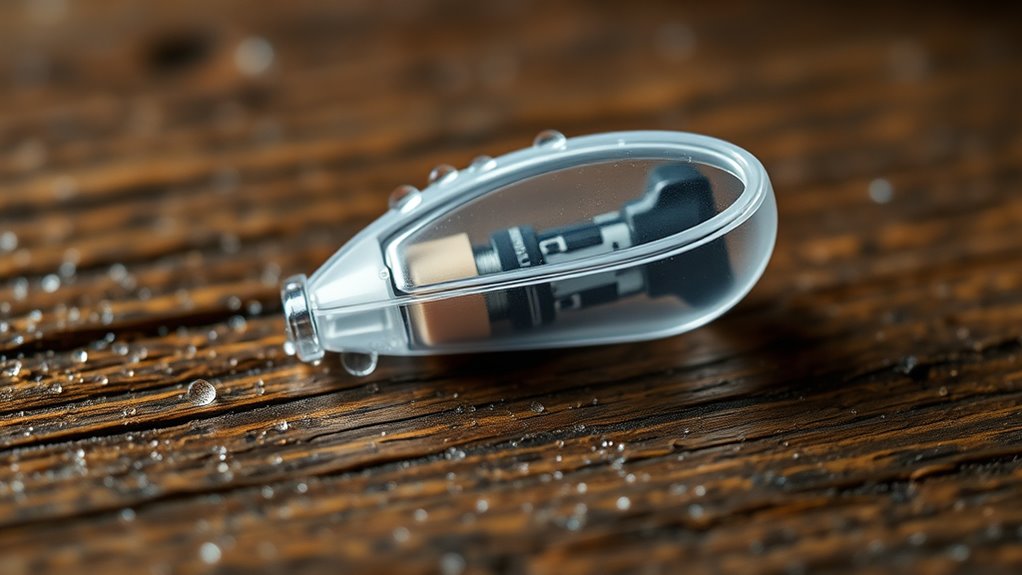
Moisture affects electronic components by creating conductive pathways that can cause short circuits and damage. When your hearing aids or devices absorb moisture, the metal parts and circuits become vulnerable to electronic corrosion, which deteriorates connections over time. Moisture absorption accelerates this process, weakening solder joints and causing component failure. The presence of moisture also promotes oxidation, further compromising the device’s functionality. Even small amounts of humidity can lead to significant problems, especially in sensitive electronic parts. Understanding this science highlights why controlling humidity levels is vital. Keeping moisture out prevents the formation of conductive bridges and reduces the risk of corrosion. Additionally, moisture management techniques are essential to maintain the integrity of electronic components. By minimizing moisture absorption, you help preserve your hearing tech’s performance, extending its lifespan and protecting your investment.
Best Practices for Protecting Hearing Aids From Humidity
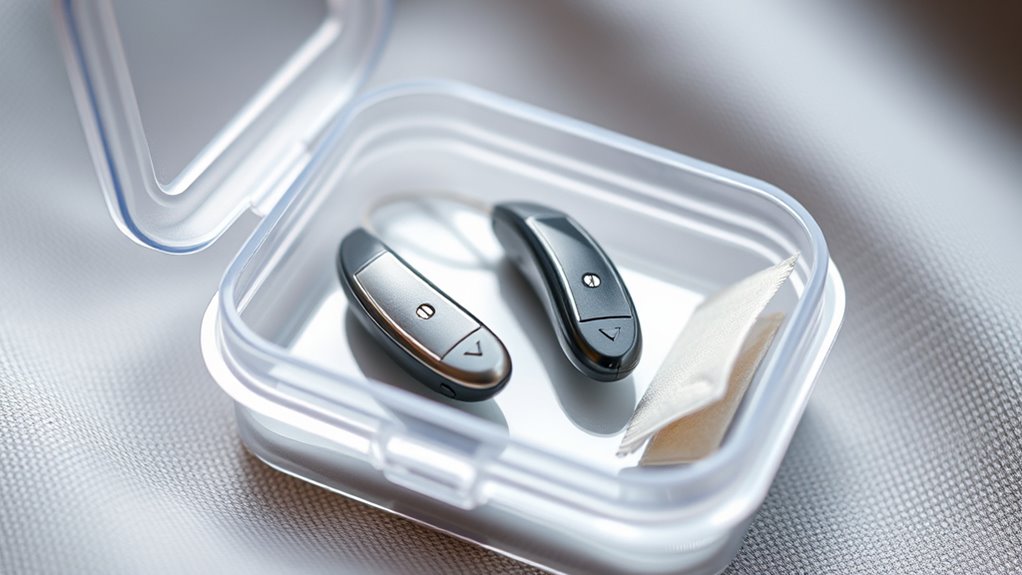
To safeguard your hearing aids from humidity, it is vital to adopt practical strategies that minimize exposure to moisture. Using devices made from innovative materials that resist moisture can markedly extend their lifespan. Regularly inspecting your hearing aids for signs of moisture buildup allows for timely intervention. Educate yourself on proper handling and maintenance techniques, such as removing batteries when not in use and avoiding wearing your aids in high-humidity environments. Consider investing in dehumidifiers specifically designed for hearing aids, which can effectively reduce moisture. User education is essential; understanding how humidity affects your devices enables you to take proactive steps. Incorporating skincare innovations like moisture-resistant components can further protect your investment. By combining innovative materials with proper care routines and informed habits, you can protect your hearing aids from humidity and guarantee optimal performance over time.
Choosing the Right Storage Solutions for Humidity Control
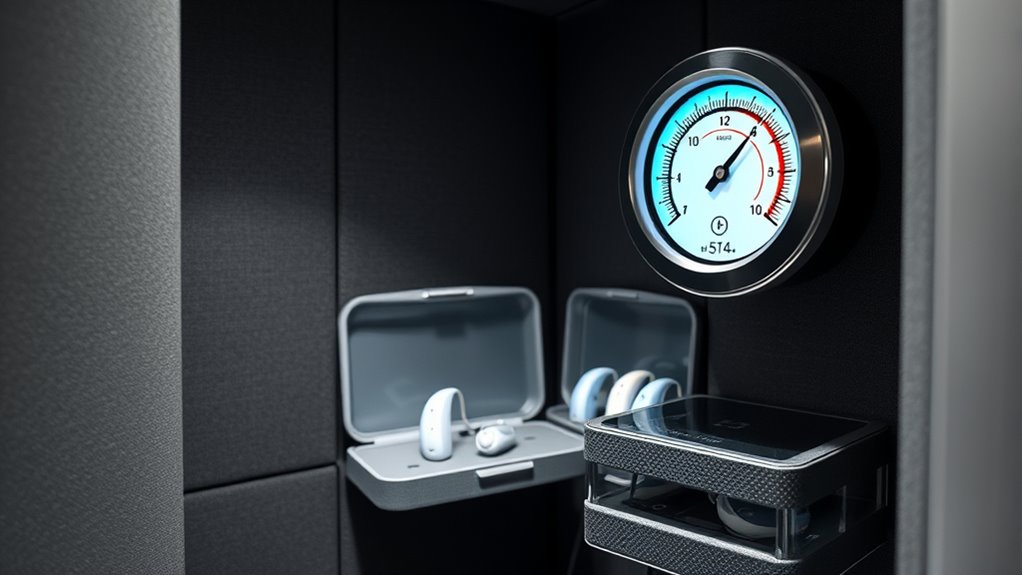
Choosing the right storage solutions is essential for maintaining your hearing aids in ideal condition, especially in humid environments. You need options that prevent moisture buildup and safeguard your devices. Using quality storage containers with moisture barriers can make a big difference. Look for containers designed specifically for electronics or hearing aids that seal tightly to keep humidity out. Incorporating Necessary Cookies or performance-enhancing features ensures your storage solution functions reliably. Selecting the right solution helps prolong your hearing aid’s lifespan and ensures excellent performance. Proper storage isn’t just about convenience—it’s about protection.
The Role of Desiccants and Dehumidifiers in Hearing Tech Care
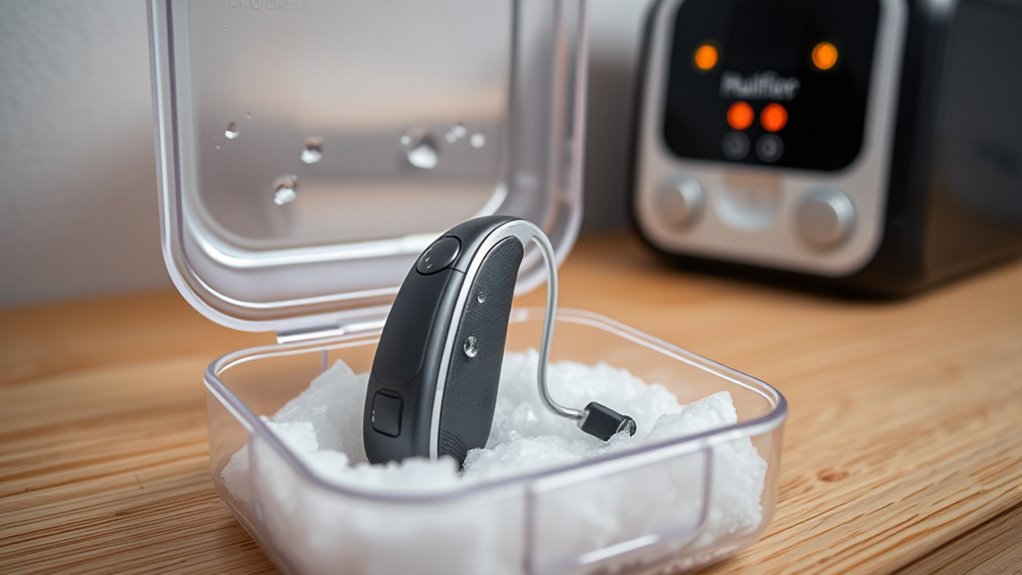
Desiccants and dehumidifiers play a vital role in protecting your hearing devices from moisture damage. They help maintain ideal humidity levels, extending the lifespan of your equipment. Choosing effective moisture control strategies guarantees your hearing tech stays reliable and in top condition. Incorporating protective styling benefits into your device maintenance routine can further enhance their durability.
Protecting Device Longevity
Since moisture can quickly damage hearing devices, incorporating desiccants and dehumidifiers is essential for protecting their longevity. Moisture buildup can interfere with wireless connectivity, causing interruptions or reduced sound quality. Using dehumidifiers or moisture-absorbing desiccants helps keep your hearing aid accessories dry, preventing corrosion and internal damage. Regularly drying your devices ensures that delicate electronic components stay functional over time. Proper moisture control also minimizes the risk of mold and bacteria growth, which can affect hygiene and performance. By maintaining a dry environment, you extend the lifespan of your hearing aids and keep their features, like wireless connectivity, working reliably. Protecting your investment means taking proactive steps to prevent moisture-related issues from shortening your device’s lifespan.
Moisture Control Strategies
Moisture control is crucial for maintaining the performance and longevity of your hearing devices, and effective strategies involve the use of desiccants and dehumidifiers. Humidity management helps prevent moisture buildup that can damage sensitive components. Desiccants absorb excess moisture inside your devices or storage cases, offering a simple moisture prevention method. Dehumidifiers actively remove moisture from the air in your environment, reducing humidity levels around your hearing tech. Regular use of these tools minimizes the risk of corrosion, mold, and other moisture-related issues. Additionally, understanding headphone jack types can help ensure proper connections and prevent damage due to moisture exposure. By implementing moisture control strategies, you protect your investment and ensure your hearing devices function at their best for years to come. Proper humidity management is a critical part of hearing tech care and longevity.
Choosing Effective Desiccants
Choosing the right desiccant is essential for effectively protecting your hearing devices from moisture damage. You want a desiccant with high desiccant effectiveness to guarantee maximum moisture absorption. Look for silica gel or other proven moisture-absorbing materials that can quickly draw out humidity from your device case. The effectiveness of a desiccant depends on its ability to absorb moisture without becoming saturated too quickly. Regularly replacing or recharging the desiccant keeps it functioning at its best, preventing excess humidity that could harm your hearing tech. Using a reliable desiccant not only prolongs the lifespan of your devices but also maintains their performance. Invest in quality moisture absorption solutions to safeguard your hearing aids and ensure they stay dry and fully functional over time. Proper tuning and maintenance of your hearing tech can further enhance its durability and performance.
Environmental Factors to Monitor for Device Longevity
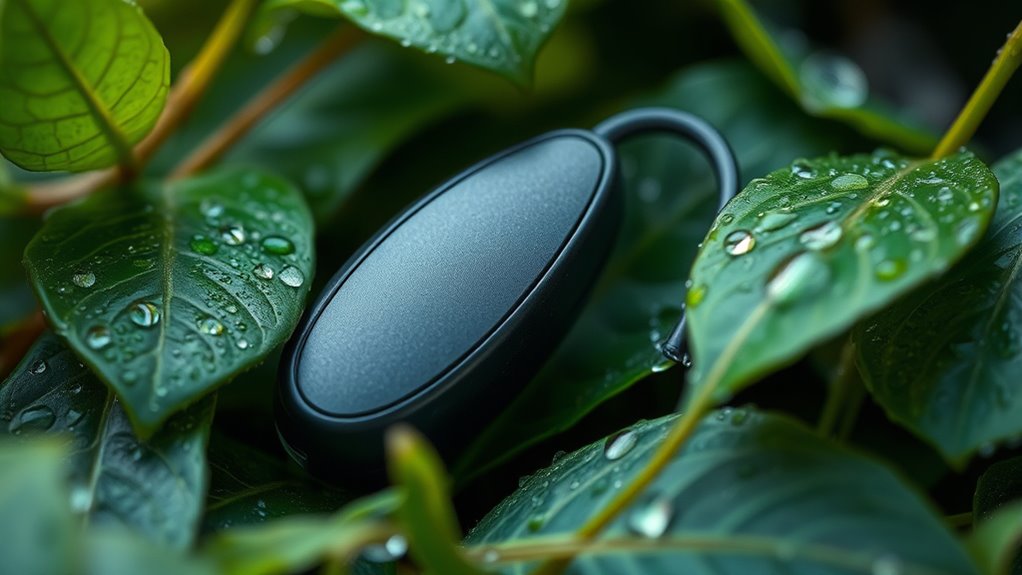
To keep your hearing devices working well, you need to watch out for environmental factors like humidity levels and temperature changes. Fluctuations can damage your devices over time, especially if they aren’t stored properly. Making simple adjustments in storage practices can extend the lifespan of your technology and guarantee it performs reliably. Ensuring your devices are protected from damage or defects caused by improper conditions is essential for safety and longevity.
Humidity Levels and Devices
Humidity levels can markedly impact the performance and durability of hearing devices. Excess moisture can cause corrosion, damage internal components, and hinder wireless connectivity. To protect your investment, monitor humidity and take preventive steps. Consider these factors:
- Use dehumidifiers or drying kits regularly to keep devices dry
- Store devices in moisture-controlled environments when not in use
- Avoid exposing devices to high humidity areas, like bathrooms or kitchens
- Ensure your device’s battery remains optimized by preventing moisture buildup
- Regularly check for signs of moisture or corrosion that could affect wireless connectivity
- Incorporate humidity monitoring into your device care routine to detect environmental risks early
Keeping humidity in check not only prolongs device life but also ensures consistent performance, especially with features like wireless connectivity and battery optimization.
Temperature Fluctuations Impact
Temperature fluctuations can substantially affect the lifespan and performance of your hearing devices. Your devices are sensitive to temperature sensitivity, which means extreme or rapid changes can cause internal components to expand or contract, risking damage. Climate variability, such as moving between hot and cold environments, accelerates wear and reduces device longevity. Sudden temperature shifts may also interfere with batteries, causing them to drain faster or malfunction. To protect your investment, avoid exposing your hearing devices to direct sunlight, heat sources, or freezing temperatures. Regularly monitor environmental conditions, especially when traveling or changing climates. Proper handling and awareness of temperature fluctuations help confirm your devices continue functioning at their best and last longer, saving you money and maintaining your hearing health.
Proper Storage Practices
Proper storage is essential to keep your hearing devices working ideally for years to come. To protect them from moisture and environmental damage, use well-ventilated storage containers. Keep silica gel packets nearby to absorb excess humidity, preventing corrosion and malfunction. Avoid leaving devices in hot or damp places, like bathrooms or car dashboards. Store your hearing aids in a cool, dry area, away from direct sunlight. Make sure the storage space is free of dust and debris, which can interfere with device components. Regularly check silica gel packets for saturation and replace them when needed. Using the right storage practices helps extend your device’s lifespan and ensures optimal performance over time.
Tips for Maintaining Hearing Devices in Humid Climates
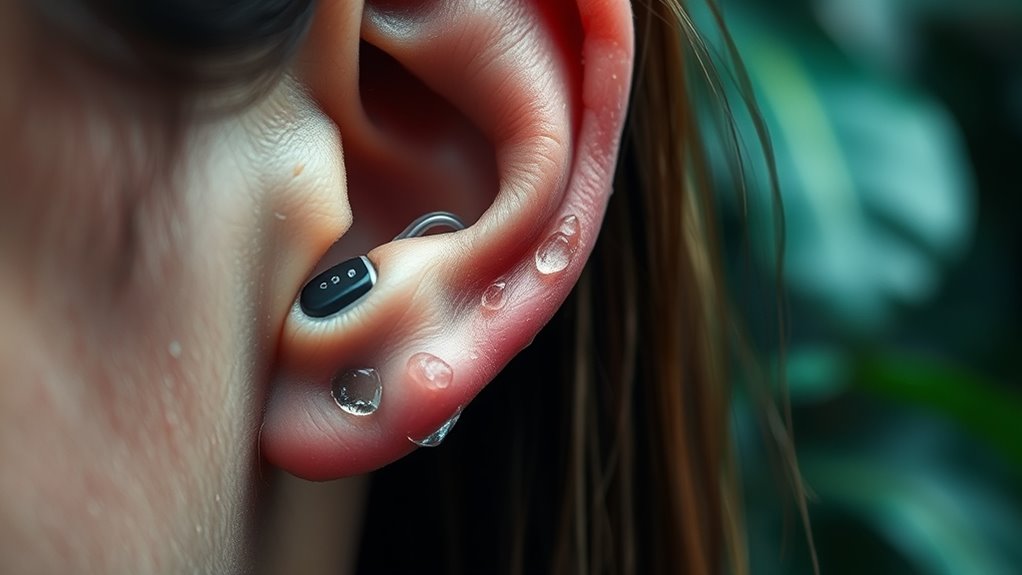
Living in a humid climate can pose unique challenges for keeping your hearing devices functioning smoothly. To prevent moisture buildup, regularly clean and dry your devices, using a soft cloth and hearing aid accessories like dehumidifiers. Be mindful of fashion trends when selecting accessories—choose breathable, moisture-resistant options that complement your style. Avoid exposing your devices to excessive heat or humidity, and remove them during activities like sweating or swimming. Store your hearing aids in a dry, ventilated case when not in use, especially after exposure to humidity. Consider investing in a portable dehumidifier to protect your tech on the go. These simple tips help preserve your devices’ performance and lifespan, ensuring you stay connected without interruption.
Frequently Asked Questions
How Does Humidity Affect the Lifespan of Hearing Device Batteries?
Humidity can considerably impact your hearing device batteries by accelerating battery degradation and increasing corrosion risk. Excess moisture causes internal components to break down faster, reducing battery life and performance. You might notice your batteries draining quicker or failing unexpectedly. To protect your investment, keep your devices in dry environments, use dehumidifiers, and regularly check for signs of corrosion. Proper care ensures your hearing tech stays functional longer.
Can Humidity Cause Hearing Aids to Malfunction Unexpectedly?
Humidity can indeed cause your hearing aids to malfunction unexpectedly. Excess moisture may lead to humidity damage, affecting internal components and causing tech malfunction. If you don’t take precautions, your devices might stop working when you least expect it. To protect your investment, keep your hearing aids dry and store them properly. Regular maintenance and using dehumidifiers can help prevent humidity damage and guarantee your hearing aids function reliably.
Are There Specific Humidity Levels Recommended for Storing Hearing Tech?
You should aim to keep humidity levels between 30% and 50% for ideal device storage. Proper humidity control prevents moisture buildup that can damage your hearing aids. Store your devices in a dry, cool place, and consider using a dehumidifier or drying kit. Maintaining these levels helps guarantee your hearing tech stays functional and extends its lifespan, protecting your investment from moisture-related malfunctions.
What Signs Indicate Moisture Has Compromised Hearing Device Circuitry?
You’ll notice moisture ingress if your hearing device starts to malfunction, such as reduced sound quality or intermittent operation. Corrosion indicators might include discoloration or a rusty appearance on the device’s metal parts. Additionally, you could experience increased static or a damp smell. If you see these signs, it’s a clear sign moisture has compromised the circuitry, and you should seek professional help to prevent further damage.
How Often Should Hearing Devices Be Checked for Humidity-Related Damage?
You should have your hearing devices checked regularly for humidity-related damage, ideally every 3 to 6 months. Humidity sensors help monitor moisture levels, and routine inspections ensure moisture control is effective. If you notice issues like reduced sound quality or condensation, get your devices checked sooner. Regular maintenance prevents moisture from damaging circuitry, extending your device’s lifespan and guaranteeing peak performance.
Conclusion
So, next time you forget to keep your hearing aids dry, remember—they’re not just fancy tech, they’re your personal moisture magnet. Ignoring humidity risks turning your investment into a high-tech paperweight. Protect your devices like you’d guard your secrets—carefully and with a little help from desiccants. Because, honestly, who wants to spend more on repairs than on that fancy new gadget? Keep them dry, keep them happy, and avoid turning your hearing aids into aquatic life.

